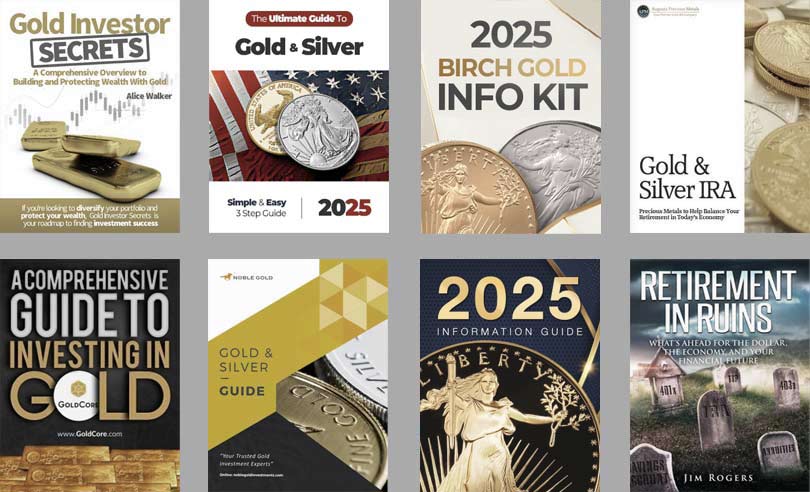JP Morgan repatriated massive quantities of gold bullion; COMEX stockpile swells by $39 billion
 Bullion.Directory precious metals analysis 07 February, 2024
Bullion.Directory precious metals analysis 07 February, 2024
By Peter Reagan
Financial Market Strategist at Birch Gold Group
News that JP Morgan is shipping back $4 billion in gold bullion back into the U.S. isn’t surprising, considering the ongoing tariff threat.
Listen, I want to remind you all that virtually everyone in mainstream financial news who mentioned gold at all said a Trump administration would not be good for gold. Because it’s a matter of record that the first Trump administration saw gold’s price rise 63% in just four years.
Soon, we returned to reality, where the basics of Trump’s preferred tariff approach lend themselves extremely well towards gold.
Trump finds the U.S. dollar overvalued and likes tariffs which cause inflation, a trick the President claims our trade partners abuse to the extreme to gain an advantage.
Gold certainly wouldn’t mind a yen-like dollar, but it is doing well in the green variety just the same. A few things stand out about this “repatriation.”
It isn’t technically that as it comes from the private sector, but given the size of names and weight of bullion, one wants to insert it in-between all those repatriations from central banks.
First is that this is the second-largest physical bullion delivery to their vaults since 1994, indicating something really big is going on with the gold market. As in, bigger than 2008 or 2011.
Second is that they’ve declined to comment, driving forward speculation on the subject. The choices presented to us are that they are covering and exiting their short positions, or that they are doing arbitrage.
But if they’re doing arbitrage here, that only means they’re covering and exiting the short positions of others.
Overleveraging and excessive shorting have been in the conversation since gold started to move past $2,000, and we may very well be seeing those voices proven before us.
Overall, COMEX gold bullion reserves rose by $39 billion since the election, which was two months ago.
It feels like someone wants to go there and suggest Trump will impose tariffs on U.S. gold being brought into the country. But nobody has yet, so neither will we.
So we are not presented with any satisfactory reason for what could be one of the biggest gold events in the last few decades.
$39 billion of gold pouring into the country in two months? We shouldn’t be surprised by any manner of price action from this point onwards.
London bullion-trading banks scramble to borrow central bank gold
We’ve given only limited cover to private bank insolvencies over the past two years due to the nature of money involved.
Since it was fake paper money being dealt in, it was only of limited relevance or interest to gold investors who were keen enough to move their savings into wealth.
But now it’s real money that they’re lacking in, so we have to really do need to discuss it.
It would be totally naive to find it a coincidence that London is scrambling to find gold just as COMEX gold bullion stockpiles swell by $39 billion in in two months.
How and to what extent these two events are related, though, are specifics yet to be revealed.
Some might not know that the Bank of England vaults gold for various entities, ranging from other sovereign institutions to private banks.
Physical gold deposited with the BoE can usually be delivered on demand in a couple of days. Right now, though, the delay has increased to four weeks, indicating some serious demand on the bank’s logistical operations.
BoE Governor Andrew Bailey couldn’t help but remind everyone that this is fine:
Reports of the flow of gold to New York attracted the attention of the British parliament’s Treasury Committee, one of whose members asked BoE Governor Andrew Bailey on Wednesday whether he saw any risks in this development.
“We are not in the gold standard anymore, it doesn’t have significance for policy in that sense.”
However, London remained a major gold market, and “if you want to be involved in that market and you want to trade and use your gold, you really need to have it in London,” Bailey added.
Hang on a minute – is Bailey trying to tell us gold doesn’t matter unless it’s in London?
Clearly we can’t take Governor Bailey’s response too seriously because, as a central banker, his job is to say that everything is fine. No matter what! Sometimes of course this is true. It’s during times when everything is NOT fine that this insistence, this drumbeat of unbridled optimism becomes problematic.
In a sense, he’s right… Since the 1990s, the BoE officially disowned its gold reserves, claiming the asset is outdated. Since then the BoE now custodies the gold reserve of His Majesty’s Treasury, along with everyone else who wants to play in the London bullion market.
But still, it’s weird to say that gold has no significance for monetary policy. It’s becoming an increasingly odd stance when many countries are openly heaping praise on gold, adding it to their vaults for every reason possible and more. In the third consecutive year that global central banks have added over 1,000 metric tons of gold to their vaults around the world.
It’s silly to claim that gold isn’t important, but that London IS important because of gold. Right?
Look, if nothing else this story reminds us that real gold is not like other assets. There are logistical complexities! Real people have to go into vaults with forklifts! Armored trucks must transport packed and crated bullion to the docks for ocean transport, or to the airport for a cargo jet.
Physical precious metals can’t fly across national borders at the click of a button. Some say that’s an inconvenience.
Personally, I believe this is one of the greatest strengths of both gold and silver as financial assets. They exist in the real world. They can’t be created or destroyed. They don’t spoil or rust – they simply persist, while castles in the air rise and fall all around them.
Can a gold-backed currency salvage a struggling economy?
Watching Zimbabwe’s gold-backed ZiG currency sputter through multiple devaluations (exactly as I predicted) wasn’t pleasant.
Even before all the unnecessary havoc, we pointed out that Zimbabwe’s money problem is systemic. In other words, it isn’t the currency that’s the problem, it’s Zimbabwe that’s the problem.
People trusted the U.S. Federal Reserve up to 1971 when it claimed the U.S. dollar was so and so redeemable for gold.
People wouldn’t so easily trust Zimbabwe’s central bank’s claims that their brand-new money was really backed by gold. This, by the way, is why real gold money is better! The ZiG banknote is supposed to be “backed” by the national gold reserve. But so is EVERY nation’s currency! That’s why they have gold reserves at all! The problem doesn’t go away – “backed by gold” just isn’t the same as “convertible into gold.”
“Backed by gold” means the holder of a banknote has no claim on the nation’s gold reserve. “Convertible into gold” means the banknote is indeed a claim on the nation’s gold reserve. It’s a rather subtle but important distinction. One that’s very clear to policymakers, by the way – a currency that’s convertible into gold from the nation’s reserves inherently limits the money supply. Of course, taking the nation’s gold reserve out of the central bank’s vaults and putting it into circulation among the citizens also transfers economic power from the central bank to the citizens!
Which is why you virtually never see it happen in the modern world. Except as a last resort…
Interestingly, the African Development Bank proposed that African nations share a gold standard that is partly influenced by locally-produced minerals.
Zimbabwe isn’t the only mineral-rich but economically-poor nation attempting to harness gold’s stability. Ghana has attempted to stabilize its currency by introducing gold into the monetary system directly, via minted gold coins. Uganda is stockpiling domestically-mined gold, probably in the early phases of a similar project.
Look – history shows us that gold can be a foundation for a nation to build its economy on.
But, any non-gold currency is only as trustworthy as the country making it (see Zimbabwe).
Introducing banknotes with pictures of gold on them? That’s not going to cut it – not unless citizens can walk into the central bank and exchange a banknote for physical gold. Even a tiny fraction of a gram (one Goldback note, for example, has 0.03 mg gold content. That’s not very much! However, it IS greater than zero – and that’s the difference between intrinsically valuable money and fancy pieces of paper.)
While any reintroduction of gold in the monetary system piques my interest, I’ve really learned to temper my enthusiasm. And every time a non-convertible, non-gold currency like the ZiG stumbles, I remember the original JP’s famous words:
“Gold is money. Everything else is credit.”
James Pierpont Morgan
Peter Reagan

Peter Reagan is a financial market strategist at Birch Gold Group, one of America’s leading precious metals dealers, specializing in providing gold IRAs and retirement-focused precious metals portfolios.
Peter’s in-depth analysis and commentary is published across major investment portals, news channels, popular US conservative websites and most frequently on Birch Gold Group’s own website.
This article was originally published here











 Material provided on the Bullion.Directory website is strictly for informational purposes only. The content is developed from sources believed to be providing accurate information. No information on this website is intended as investment, tax or legal advice and must not be relied upon as such. Please consult legal or tax professionals for specific information regarding your individual situation. Precious metals carry risk and investors requiring advice should always consult a properly qualified advisor. Bullion.Directory, it's staff or affiliates do not accept any liability for loss, damages, or loss of profit resulting from readers investment decisions.
Material provided on the Bullion.Directory website is strictly for informational purposes only. The content is developed from sources believed to be providing accurate information. No information on this website is intended as investment, tax or legal advice and must not be relied upon as such. Please consult legal or tax professionals for specific information regarding your individual situation. Precious metals carry risk and investors requiring advice should always consult a properly qualified advisor. Bullion.Directory, it's staff or affiliates do not accept any liability for loss, damages, or loss of profit resulting from readers investment decisions.

Leave a Reply